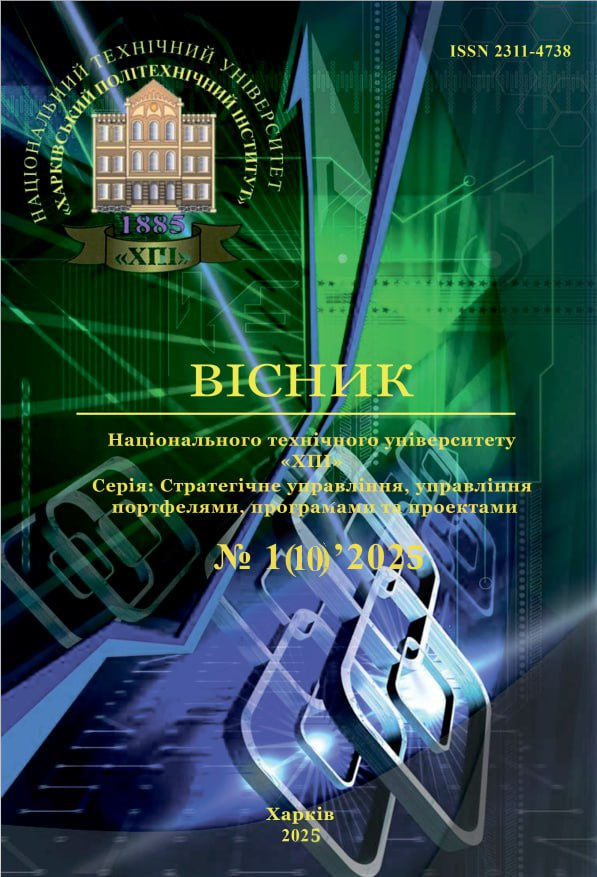MULTI-LEVEL PLANNING AND MANAGEMENT IN CONCRETE PRODUCTION DEVELOPMENT AND SUPPLY CHAINS
DOI:
https://doi.org/10.20998/2413-3000.2025.10.2Keywords:
ready-mix concrete; concrete delivery; supply chain: production and logistics planning; simulation modelingAbstract
The relevance of the research is linked to the fact that the restoration of destroyed housing stock, the reconstruction of damaged infrastructure and industrial buildings, and the resumption of work on all construction sites across the country will lead to a sharp increase in demand for concrete, which will evidently exceed existing production capacities. Therefore, one of the key priorities for Ukrainian concrete plants today must be the implementation of strategies and development projects aimed at increasing productivity without compromising quality. The purpose of this study is to enhance the efficiency of production planning and logistics for ready-mixed concrete based on a systematic approach and simulation modeling under the dynamics of market demands and constraints. The following results have been obtained. A multi-level planning model for concrete logistics has been proposed. This model considers both production and distribution processes, allowing for the alignment of supply plans with the enterprise's development strategies. The use of this model enables systematic analysis of order portfolios and production development projects to assess their feasibility at a specific enterprise, coordinate project implementation plans with enterprise strategies at various planning levels, and select orders/projects for execution according to the chosen development strategy. A simulation model for analyzing the processes of production and logistics of ready-mixed concrete has been developed. This model facilitates solving various tasks, including evaluating the rationality and efficiency of production and delivery organization, identifying bottlenecks in production and logistics processes, forecasting performance indicators of concrete plants under changing production conditions, and generating data to support decisions aimed at reducing downtime for both plants and clients. The models developed can serve as valuable tools to assist managers, dispatchers, and engineers at concrete plants in planning their operations effectively.
References
Ринок цементу та бетону України: 2023 та прогноз потреб // Readymix – Режим доступу: https://readymix.pro/rinok-cementu-ta-betonu-ukrayini-2023-ta-prognoz-potreb. – Дата звернення: 15 січня 2025.
Fitriani H., Rizki L. D. Just-in-time application on readymix concrete production. International Journal of Advanced Technology and Engineering Exploration. 2022. vol. 9. pp. 1183-1195. DOI: https://doi.org/10.19101/IJATEE.2021.876116.
Куліков О. М., Заяц О. В., Оксамитна Л. П. Сучасні підходи до управління портфелями проєктів в галузі дорожнього будівництва. Вісник НТУ «ХПІ». Серія: Стратегічне управління, управління портфелями, програмами та проектами: Збірник наукових праць. 2023. № 1 (7). С. 42-50. DOI: https://doi.org/10.20998/2413-3000.2023.7.6.
Tzanetos A., Blondin M. Systematic search and mapping review of the concrete delivery problem (CDP): Formulations, objectives, and data. Automation in Construction. 2023. vol. 145. article no. 104631. DOI: https://doi.org/10.1016/j.autcon.2022.104631.
Jaisree K. B., Palani B. Supply Chain Management in Construction Projects: A Comprehensive Analysis of the Indian Context - Review. International Journal of Research and Review. 2024. vol. 11. no. 1, pp. 298-308. DOI: https://doi.org/10.52403/ijrr.20240132.
Olugboyega O., Ejohwomu O., Omopariola E. D., Omoregie A. Sustainable Ready-Mixed Concrete (RMC) Production: A Case Study of Five RMC Plants in Nigeria. Sustainability. 2023. vol. 15. article no. 8169. DOI: https://doi.org/10.3390/su15108169.
Kim T, Kim Y-W. Proactive Production Scheduling Approach for Off-Site Construction with Due Date Uncertainty. Applied Sciences. 2024. vol. 14. no. 23, article no. 11017. DOI: https://doi.org/10.3390/app142311017.
Семенчук К. Л. Моделювання стратегій ланцюгів постачань у проєктній діяльності. Вісник НТУ «ХПІ». Серія: Стратегічне управління, управління портфелями, програмами та проектами: Збірник наукових праць. 2024. № 1 (8). С. 58-65. DOI: https://doi.org/10.20998/2413-3000.2024.8.8.
Douaioui K., Benmoussa O., Ahlaqqach M. Optimizing Supply Chain Efficiency Using Innovative Goal Programming and Advanced Metaheuristic Techniques. Applied Sciences. 2024. vol. 14. no. 16. article no. 7151. DOI: https://doi.org/10.3390/app14167151.
Anastasiu L., Câmpian C., Roman N. Boosting Construction Project Timeline: The Case of Critical Chain Project Management (CCPM). Buildings. 2023. vol. 13. no. 5. article no. 1249. DOI: https://doi.org/10.3390/buildings13051249.
Forcael E., Contreras C., Francesconi C., Baesler F. Applying Game Theory to Teach the PERT Scheduling Method. Applied Sciences. 2024. vol. 14. no. 24. article no. 12045. DOI: https://doi.org/10.3390/app142412045.
Vicente J. J. Optimizing Supply Chain Inventory: A Mixed Integer Linear Programming Approach. Systems. 2025. vol. 13. no. 1. article no. 33. DOI: https://doi.org/10.3390/systems13010033.
Matejević-Nikolić B., Živković L. Development of the Simulation Model for Ready Mixed Concrete Supply Chain Cost Structure. Tehnički vjesnik, 2023. vol. 30. no. 1. pp. 102-113. DOI: https://doi.org/10.17559/TV-20220310120002.
Buhaievskyi M., Petrenko Y. Simulation of production and logistics for concrete plants. Radioelectronic and Computer Systems. 2024. vol. 2024. no. 3. pp. 190-204. DOI: https://doi.org/10.32620/reks.2024.3.13.
Kiyko S., Druzhinin E., Prokhorov O., Haidabrus B. Multi-agent Model of Energy Consumption at the Metallurgical Enterprise. DSMIE 2020: Design, Simulation, Manufacturing: The Innovation Exchange. 2020. pp. 156-165. DOI: https://doi.org/10.1007/978-3-030-50794-7_16.
Downloads
Published
Issue
Section
License

This work is licensed under a Creative Commons Attribution-NonCommercial-ShareAlike 4.0 International License.
Our journal abides by the Creative Commons copyright rights and permissions for open access journals.
Authors who publish with this journal agree to the following terms:
Authors hold the copyright without restrictions and grant the journal right of first publication with the work simultaneously licensed under a Creative Commons Attribution-NonCommercial-ShareAlike 4.0 International License (CC BY-NC-SA 4.0) that allows others to share the work with an acknowledgement of the work's authorship and initial publication in this journal.
Authors are able to enter into separate, additional contractual arrangements for the non-commercial and non-exclusive distribution of the journal's published version of the work (e.g., post it to an institutional repository or publish it in a book), with an acknowledgement of its initial publication in this journal.
Authors are permitted and encouraged to post their published work online (e.g., in institutional repositories or on their website) as it can lead to productive exchanges, as well as earlier and greater citation of published work.

